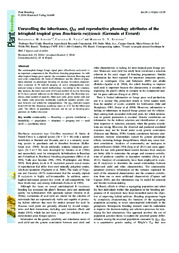Unravelling the inheritance, Qst and reproductive phenology attributes of the tetraploid tropical grass Brachiaria ruziziensis (Germain et Evrard).
Unravelling the inheritance, Qst and reproductive phenology attributes of the tetraploid tropical grass Brachiaria ruziziensis (Germain et Evrard).
Autoria: RESENDE, R. M. S.; VALLE, C. B. do; RESENDE, M. D. V.
Resumo: The autotetraploid forage Congo signal grass (Brachiaria ruziziensis) is an important component in the Brachiaria breeding programme. As with other tropical forage grass species, the association between flowering and seed yield components, the mode of inheritance and the effects of population structure on phenotypic breeding are lacking. Seventeen characteristics evaluated in 59 half-sib progeny of seven subpopulations were analysed using a mixed model methodology. According to the commonality analysis, the total seed yield (0.67) and number of days to flowering (0.22) had a greater influence on the filled-seed yield. The flowering synchrony, total number of panicles, filled-seed yield, green matter yield and dry matter yield presented statistically significant additive genetic variance between and within the subpopulations. The QST estimates ranged from 0.09 for the flowering synchrony index to 0.31 for the filled-seed yield. The effects of population structure and its use in breeding programmes are further discussed.
Ano de publicação: 2017
Tipo de publicação: Artigo de periódico
Unidade: Embrapa Gado de Corte
Palavras-chave: Commonality, Flowering, Genetic correlation, Heritability, Population, Progeny testing, Seed yield, Synchrony index
Observações
1 - Por padrão são exibidas publicações dos últimos 20 anos. Para encontrar publicações mais antigas, configure o filtro ano de publicação, colocando o ano a partir do qual você deseja encontrar publicações. O filtro está na coluna da esquerda na busca acima.
2 - Para ler algumas publicações da Embrapa (apenas as que estão em formato ePub), é necessário ter, no celular ou computador, um desses softwares gratuitos. Sistemas Android: Google Play Livros; IOS: iBooks; Windows e Linux: software Calibre.
Acesse outras publicações
Acesse a Base de Dados da Pesquisa Agropecuária (BDPA) para consultar o acervo completo das bibliotecas da Embrapa.

